Celebrated but Waning Conservation Program Turns 25
OutdoorHub 07.18.11

The Conservation Reserve Program turns 25 this year. While there is much to laud about this conservation program that has benefitted ground-nesting birds and other wildlife while safeguarding millions of acres of marginal cropland, it’s a bittersweet celebration.
Though North Dakota gained nearly 132,000 new CRP acres in a March-April signup, contracts involving about 387,000 acres will expire by fall, leaving the state 1 million acres poorer since 2007, when more than 3 million acres blanketed the landscape.
The U.S. Department of Agriculture’s Conservation Reserve Program was signed into law in 1985 to reduce grain surpluses to jumpstart commodity prices, and decrease erosion on marginal croplands. Lands enrolled in CRP are planted in grass and left mostly undisturbed for 10 years or more with periodic management, such has haying or grazing. Landowners receive rental payments and cost-share assistance to participate in the voluntary program.
“CRP pretty much did what it was supposed to do,” according to Greg Link, assistant chief of the North Dakota Game and Fish Department’s wildlife division. “Commodity prices gradually improved and soil erosion decreased. We knew it would benefit wildlife if enough landowners enrolled enough acres. As wildlife populations flourished, interest from hunters grew. If anything, the program probably exceeded expectations.”
CRP was at its peak in North Dakota in 2007 when the state had 3.4 million acres of mostly idle grassland. A reduced nationwide cap, cut from 39 million acres to 32 million acres in the 2008 Farm Bill, along with other factors like high commodity prices, high cash rents, and demands for more cropland for food and fuel production, have slowly reduced interest in the program in North Dakota and elsewhere.
With deliberations already underway on a new farm bill, feedback points to an even lower nationwide CRP cap in the future. Once a staple on North Dakota’s landscape, some projections indicate the state will have fewer than 1 million acres by the end of 2013. If that happens, ground-nesting pheasant and duck populations will be hit the hardest.
In the future, Link said, finding places to hunt and finding game to pursue will be much more difficult. As a result, the number of resident and nonresident hunters most likely will decline.
“Unless something changes, the future for the program is not bright,” Link said. “It’s not just the loss of wildlife habitat, but CRP is a major ingredient in the department’s Private Land Open To Sportsmen program, and that will likely shrink because there is no way to have the same quality habitat and the same amount of habitat available without CRP.”

